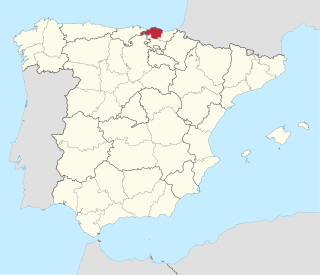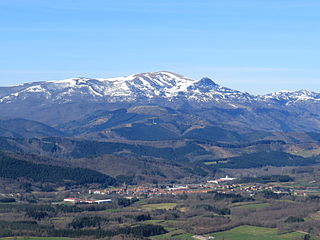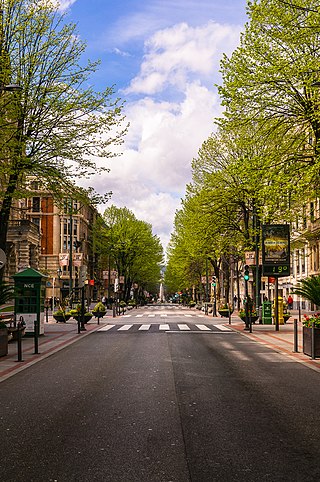
Biscay or Bizkaia, is a province of the Basque Autonomous Community, heir of the ancient Lordship of Biscay, lying on the south shore of the eponymous bay. The capital and largest city is Bilbao.

Downtown Los Angeles (DTLA) is the central business district of Los Angeles. It is part of the Central Los Angeles region and covers a 5.84 sq mi (15.1 km2) area. As of 2020, it contains over 500,000 jobs and has a population of roughly 85,000 residents, with an estimated daytime population of over 200,000 people prior to the COVID-19 pandemic.

Palermo is a barrio or neighborhood of Buenos Aires, Argentina. It is located in the north of the city, near the Río de la Plata.

Portugalete is a town lying to the west of Bilbao in the province of Biscay in the Autonomous Community of the Basque Country, northern Spain.

Getxo is a town located in the province of Biscay, in the autonomous community of the Basque Country, in Spain. It is part of Greater Bilbao, and has 75,430 inhabitants (2023). Getxo is mostly an affluent residential area, as well as being the third largest municipality of Biscay.

Otxandio is a town and municipality located in the province of Biscay, in the Basque autonomous community, Spain. Otxandio is part of the comarca of Durangaldea and has a population of 1,269 inhabitants as of 2010 according to the Spanish National Statistics Institute.

Areeta is a neighbourhood of Getxo. It is an affluent residential area that was built over the sands of a beach where the Gobela Creek died into a diffuse delta at the mouth of the Estuary of Bilbao in the early 20th century.

Neguri is an affluent district of Getxo, in Biscay, Basque Country in Spain. It is traditionally regarded as the residence of the prosperous Basque industrial bourgeoisie. Its name, coined in the 19th century, means Winter Town in Basque language.

Deusto, also known as Deustu in Basque and formerly known as San Pedro de Deusto, is one of the eight districts of Bilbao, Spain. It is located on the right side of the Bilbao estuary, in the northwestern part of the city and bordering the estuary itself on the south and the southern hillside of Mount Artxanda and Mount Bandera on the north. Deusto was originally an elizate and also a municipality until 1925 when it was completely annexed by Bilbao in order to expand the free land available to the city. Deusto is known as the university district of the city as it is home to the University of Deusto and the Faculty of Economics and Business of the University of the Basque Country.

Abando, formerly known as San Vicente de Abando, is one of the eight districts of Bilbao, Basque Country (Spain). It covers most of the city's centre, located on the left bank of the estuary of Bilbao. It is the only district of Bilbao with all of its land completely urbanised. Abando was originally an elizate and also a municipality until 1876, when part of it was annexed to Bilbao, the rest of the elizate's municipal land was integrated into Bilbao in 1890. In 2016 the population was 50,903. Abando is the wealthiest district in Bilbao, with personal and family incomes being well above the citywide average.

Las Siete Calles or Casco Viejo in Spanish or Zazpikaleak or Alde Zaharra in Basque are different names for the medieval neighbourhood of Bilbao, part of the Ibaiondo district. The walled section of the town existed until the end of the 19th century and was known by the names Seven Streets or Old Town, respectively.

San Sebastián, officially known by the bilingual name Donostia / San Sebastián, is a city and municipality located in the Basque Autonomous Community, Spain. It lies on the coast of the Bay of Biscay, 20 km from the France–Spain border. The capital city of the province of Gipuzkoa, the municipality's population is 188,102 as of 2021, with its metropolitan area reaching 436,500 in 2010. Locals call themselves donostiarra (singular), both in Spanish and Basque. It is also a part of Basque Eurocity Bayonne-San Sebastián.

Lavapiés is a historic neighbourhood in the city of Madrid, Spain. It is located in the administrative ward (barrio) of Embajadores in the downtown Centro District, southwest of neighbouring neighbourhood La Latina.

Zazpikaleak/Casco Viejo – Zazpikaleak and Casco Viejo – is a railway station in Bilbao, Basque Country, Spain. It is located in the historical neighborhood of Casco Viejo, in the district of Ibaiondo. It links the Bilbao metro rapid transit services with the Euskotren Trena commuter rail network. It is the main railway hub for trips between the metropolitan underground network and the railway services to Eibar, Gernika, Bermeo and San Sebastián as well as the Txorierri valley. The original metro station opened on 11 November 1995, and on 8 April 2017 in its current form.

Gobela is a station on line 1 of the Bilbao metro. It is located in the neighborhood of Itzubaltzeta-Romo, in the municipality of Getxo. The station opened as part of the metro on 24 June 1996, replacing an older station. It is located immediately to the west of Campo Municipal de Gobela, home of the football team Arenas Club de Getxo.

Neguri is a station on line 1 of the Bilbao metro. It is located in the neighborhood of Neguri, in the municipality of Getxo. The station opened as part of the metro on 11 November 1995, replacing an older station.

Algorta is a station on line 1 of the Bilbao metro. It is located in the neighborhood of Algorta, in the municipality of Getxo. The station opened as part of the metro on 11 November 1995, replacing an older station.

Bidezabal is a station on line 1 of the Bilbao metro. It is located in the neighborhood of Algorta, in the municipality of Getxo. The station opened as part of the metro on 11 November 1995.

Colonia Guerrero is a colonia of Mexico City located just north-northwest of the historic center. Its borders are formed by Ricardo Flores Magón to the north, Eje Central Lazaro Cardenas and Paseo de la Reforma to the east, Eje1 Poniente Guerrero to the west and Avenida Hidalgo to the south. The colonia has a long history, beginning as an indigenous neighborhood in the colonial period called Cuepopan. The origins of the modern colonia begin in the first half of the 19th century, but most of its development occurred as a residential area in the late 19th and early 20th. Over the 20th century, several rail lines and major arteries were built through here, changing its character Cuauhtémoc borough. It is home to two early colonial era churches, the Franz Mayer Museum and one Neo-Gothic church from the Porfirian era.
Manuel María Smith Ibarra was a Spanish architect. He carried out numerous constructions for the Basque bourgeoisie. He is considered the introducer of the English style in the Basque Country. He promoted low-density housing, considering it ideal for any social stratum. His best-known work was the San Mamés stadium, the football field in which Athletic Bilbao played its home matches until 2013.



















